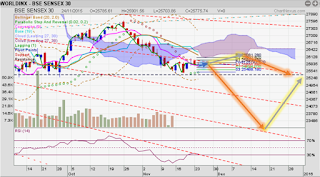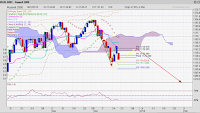ASIA UPDATE Part 2 - India, Singapore, and more
Weekly Brief (Nov 30 to Dec 4)
Wasn't the week a barrage of conflicting messages and events! Volatility in financial markets picked up steam though hardly in logical consequence to the news. Correlation between assets and markets became close to 100% in US and Europe: as stock prices rose, yields rose, too, as did gold and silver prices, at least the last 2 days of the week. In Asia, however, markets moved in range, almost unperturbed by the hectic in developed world.
Equities in US & EU
The week started off with US and EU equities drifting gently lower, then a boisterous upswing on Tuesday, December 1st, yet erasing it on Wednesday. Thursday brought more downside and traders braced themselves for a negative weekly return. But on Friday, equities rallied strongly, ending the week close to the levels where it began.
Bonds
US Bond yields had been falling for almost a month, yet on Thursday, they rose 20 basis points for the 10-year Treasury bill, dropping bond prices to early November levels.
Except for Greek bonds, Euro bond yields have been falling along with US bonds. Thursday and Friday negated much of the bond price advance it had achieved in November.
All this because the employment figures looked better than expected? Or FED Chairwoman Yellen's statement, "...looking forward to normalising interest rates"? Was it not the same trigger bringing equities and yields down last month, as people feared the possible fallout of an interest rate rise on December 7?
In Asia, bond yields had been rising for more than a month, and bond prices kept falling. Yet, - investors keep buying bonds, as the fund listing for highest purchase volumes at fundsupermart in Singapore shows. To make matters worse, enormous volatility in Asia's local currencies have become a bane for investor strategies.What have the savvy advisors been telling their clients?!
Commodities (including Gold/Silver)
Roller coaster prices for weeks, and now the turnaround? Prices in gold fell as low as $1,040 the ounce on Wednesday. The Friday close was $1,086, a swing of 4%. Mining stocks did not enjoy a similar rebound and are languishing near multi month lows. Silver prices moved even more erratic. And oil, well, its prices fluctuate wildly not just as a result of currency, but mainly to events in Middle East. It does bode well for a bullish scenario, despite bombing DAESH oil fields and OPEC without a decision on what to do about production levels.
The USD Drop
The Dollar/EUR pair displayed the most drastic movements in months! On Thursday, it dropped from 100.6 to 97.6, or about 3%, completely wiping out the advance of the whole of November. This was supposedly triggered by the ECB's decision to increase the negative interest by just 0.1% instead of 0.2% as the "markets" had anticipated. (Negative interest means the investor pays the bond issuer/bank to let him keep your money...)
The Coming Week
I stated repeatedly that volatility throughout financial markets will go up - and quite possibly manifest in the world at large. Some US presidential candidates certainly give their 'best' to make sure of that. The level of police in riot gear and military personnel on the streets of Europe, as I can see it, is unprecedented and more reminiscent of sci-fi movie, leaving many ill at ease.
Such scenes tie in with the outlook in cycles. It even seems to suggest that an interest rate rise will not change the prevailing trend of a weakening or range trading USD. It could, though, result in more confusion until its impact on the various assets and regions in the world becomes apparent.
MORE ASIAN UPDATES
INDIA
 |
| BSE SENSEX, Nov 2015, with Dec outlook source, Chartnexus |
India's equity market has been correcting since February. None of the world's events during the last 9 months has made a difference. I don't think that this will change near term. So please be mindful of more downside potential.
My arrows provide two potential scenarios in December, none of them offering a positive return. At best it will be a sideways market, more - or less - volatile. The Indian Rupee also does not offer any help. It has been losing value against the USD for over a year now.
Singapore
 |
| STI for 2015 with forecast to Jan 2016 source: Chartnexus |
My former home is suffering a major economic downturn. The property market still remains hugely overvalued, and politics won't allow a correction in accordance with market forces,- yet. Instead, the Singapore dollar has been on a downward trend of some magnitude against the USD. But the bigger correction is happening in its stock exchange, the STI. Since April 2015, it has lost near enough 20% so far, more - if we take the losses of the SGD into account. Scenarios like 1997 and 2002 spring to mind as the deterioration is set to continue in 2016. The strength of its banks - and bonds is the only consolation for the time being. However, even its position as the most prominent Asian financial centre is being challenged by Hong Kong and other countries in the region. Its share of the pie is diminishing while - in pure numbers - its local businesses might still see growth. For how long?
KOREA
 |
| KOSPI 2015 with outlook to Jan 2016, source: Chartnexus |
The country has been in the shadow of Japan's export might, and subsequently attracted only peripheral interest. Its stock market index, the KOSPI has been consolidating since April, too, but the October recovery of more than 50% of the preceding losses offers some hope of better days ahead. In the short-term, however, the cycles point sideways, with January 2016 being the month of reckoning. Thereafter, a substantial rally may be in the offing.
Thailand
 |
| THAI SET 2015, with outlook to Jan 2016, source: http://ieconomics.com/ |
Indonesia
 |
| JKSE 2015, with outlook to January 2016, source: http://ieconomics.com/ |
The country has been a foreign investor darling, more so than many other emerging markets, for many years. Often, that leaves its stock prices at the mercy of the investment flow. If foreigners buy, the market will rally. If they sell, prices will go down. In 2015, the stock index, JKSE, was 100% correlated to other ASEAN countries, including Singapore and Thailand. Thus the chart looks very similar,and the losses, too, as does the fate of the Indonesian Rupiah, which has lost against the USD. I don't see any reason why the forecast should be different. The only light at the end of the tunnel is that in the case of Indonesia, the lows of October might just hold, mid-term.
The outlook for 2016, globally is in preparation. However, I will not be publicizing it till late January 2016. Only at that point will I hopefully have some certainty with regards to actual levels and prospective performances.



Comments